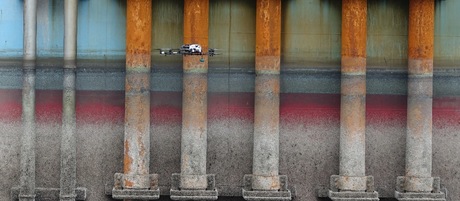Drone technology flies in the face of risk

‘Eyes in the sky’ technology will be the future for conducting quick and safe inspections of critical infrastructure and for reducing risk exposure to workers across a number of industries, according to engineering company Lloyd’s Register.
New guidance material for drones and unmanned aircraft systems (UAS) has been released by the company to give operators in the energy and marine industries confidence in using UAS for offshore, marine and onshore surveys and in-service inspections.
“We are developing these guidance notes to provide a consistent approach to risk in UAS and drone deployment, offering practical operational considerations relating to regulations, personnel, quality, safety, hardware, software and operations,” said Nial McCollam, Lloyd’s Register’s chief technology officer.
“Technology and innovation in the area of digital data, sensing technologies, unmanned systems and robotics are here to stay. We see an exciting and important journey ahead, and anticipate our efforts to increase and continue.”
UAS, also commonly known as drones, provide an alternative to traditional methods of surveys and inspections, especially for structures and assets at significant heights, locations that are hard to access and hazardous environments. The drones are piloted remotely or autonomously, which reduces the need to send personnel into high-risk and challenging areas, and therefore can help to decrease the number of falls and fatalities that occur from working at heights.
In the past, small commercial UAS technology can be traced back to remote-controlled hobby aircraft, requiring significant skills to operate. However, rapid advancements in hardware and software, including air stabilisation, pre-flight planning tools, obstacle detection and avoidance technology, have transformed these small aircraft into viable business tools, likened to high-definition eyes in the sky.
Major operators such as Shell and Maersk Drilling are among the early adopters of the innovative technology. Maersk Drilling is one of the companies that has partnered with Lloyd’s Register for a number of pilots conducted to assess the drone’s capabilities for inspection at heights and difficult areas.
Jan Holm, managing director of Maersk Drilling in Singapore, said the company can see the technology has a number of potential applications, which has triggered ideas on new applications.
“One area we want to focus on is the safety aspect of this new technology, and how we integrate it with existing safety processes,” said Holm.
He said the guidance notes will help industry take on board important safety considerations of the technology for various applications.
“It only takes one or two accidents or near miss reports to set a bad record for robotics and unmanned systems in the industry.”
The guidance material will be regularly updated to provide industry with the latest practical information, such as how best to use UAS for inspection in confined spaces — particularly relevant in energy and marine applications where Class surveys are needed.
Unlocking further potential
In March 2016, the Lloyd’s Register Foundation convened an international panel of industry and academic experts for a two-day workshop on Robotics and Autonomous Systems (RAS). The foundation is expected to significantly invest in areas identified from the workshop, highlighted in a review to be published later in the year.
“We have been looking into robotics and unmanned systems for years, not just on the technology but also on design codes, policies and guidelines on safe and sustainable deployment. We see UAS as part of the unmanned systems and robotics story, which also includes underwater and ground-based systems,” said Chris Chung, head of strategic research at Lloyd’s Register.
“In addition to tried and tested applications such as safely inspecting assets of flare stacks and other outdoor critical infrastructure, we are collaborating with industry to enable inspection of the undersides of offshore structures and maritime vessels and confined spaces such as storage tanks.
“With increasing capabilities, we believe UAS will in the future have the ability to autonomously follow a predefined flight path, enabling higher measurement accuracy and repetition of collecting more relevant data and operational defects while inspecting and data-gathering in real time.”
UAS is also expected to play a fundamental part in emergency response and improving situational awareness in the future.
“A major challenge in any emergency situation is the lack of timely and accurate information on which to base informed decisions. In such instances, UAS can be used to gather data without sending in personnel, or at least limiting their risk exposure,” added Chung.
For more information, go to http://info.lr.org/unmanned-aircraft-systems.
Originally published here.
Rock lobster processor and exporter finds driver safety partner
A transport technology solutions provider has announced a new contract to enhance safety with...
Level crossing AI safety solution has merit
Among the merit recipients in the 2025 VIC iAwards was an edge AI solution designed to enhance...
Laser bird deterrent boosts tram depot safety
A Melbourne tram depot has reduced bird roosting by 90%, boosting safety through a fully...









